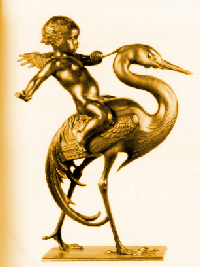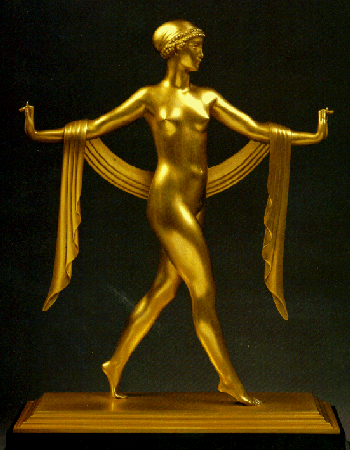|
|
|
|
![]() orn
in Stuttgart, Germany, on December 20, 1890, Carl Paul Jennewein, came
to the United States in 1907 and studied at the Art Students League in
New York from 1908 to 1911. He returned to Europe and received the Prix
de Rome in 1916. During four years of advanced study he produced a number
of distinguished works including Cupid and Crane in 1925 as a companion
piece to Cupid and Gazelle to celebrate the birth of his third child,
Alessandro.
orn
in Stuttgart, Germany, on December 20, 1890, Carl Paul Jennewein, came
to the United States in 1907 and studied at the Art Students League in
New York from 1908 to 1911. He returned to Europe and received the Prix
de Rome in 1916. During four years of advanced study he produced a number
of distinguished works including Cupid and Crane in 1925 as a companion
piece to Cupid and Gazelle to celebrate the birth of his third child,
Alessandro.
 |
Jennewein returned to the USA and executed an important sculptural commission, a polychromed terracotta in the Hellenistic style, for the west wing of the Philadelphia Museum of Art.
While designing that work on a trip to Rome, Jennewein created the Art Deco classic you see here, The Greek Dance. An edition of 25 was cast in bronze and a smaller number in silver.
![]() n
order to secure commissions, Jennewein necessarily applied traditional
styles for his larger works, but he was strongly influenced by Modernist
styles for his smaller works. One of his designs defies classification:
The Federal Office Building in New York features his eagle relief, which
embodies a pointed geometrical pattern not far different from abstraction.
Other commercial commissions in New York included the A. T. & T. Building
and the bas reliefs on the RCA Building.
n
order to secure commissions, Jennewein necessarily applied traditional
styles for his larger works, but he was strongly influenced by Modernist
styles for his smaller works. One of his designs defies classification:
The Federal Office Building in New York features his eagle relief, which
embodies a pointed geometrical pattern not far different from abstraction.
Other commercial commissions in New York included the A. T. & T. Building
and the bas reliefs on the RCA Building.
 |
|
|
|
|